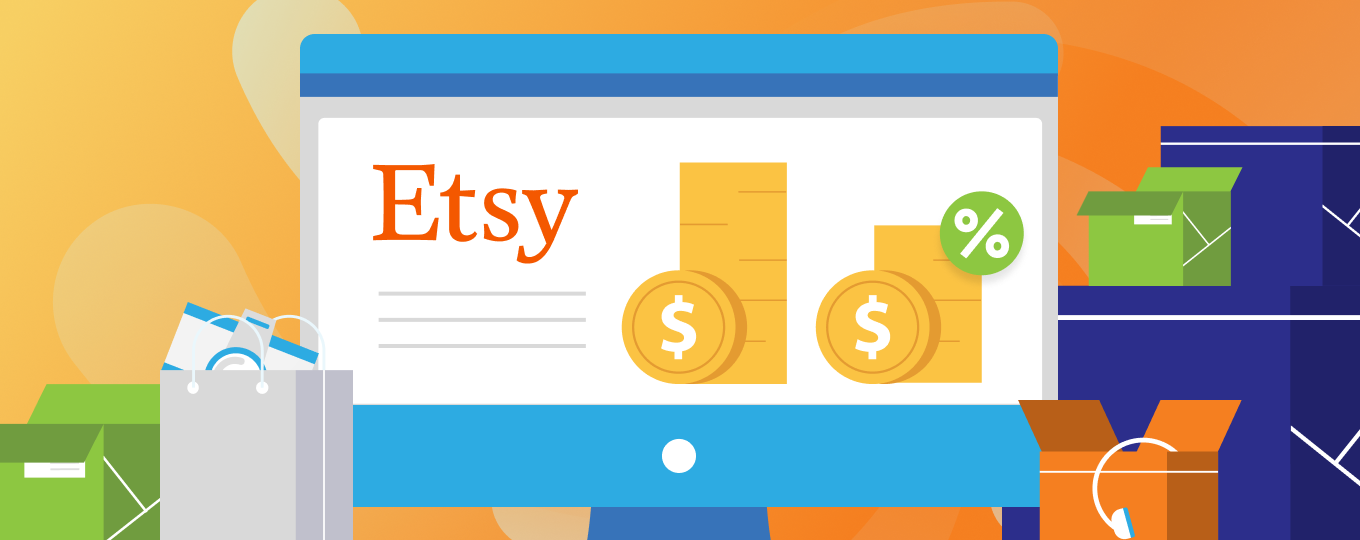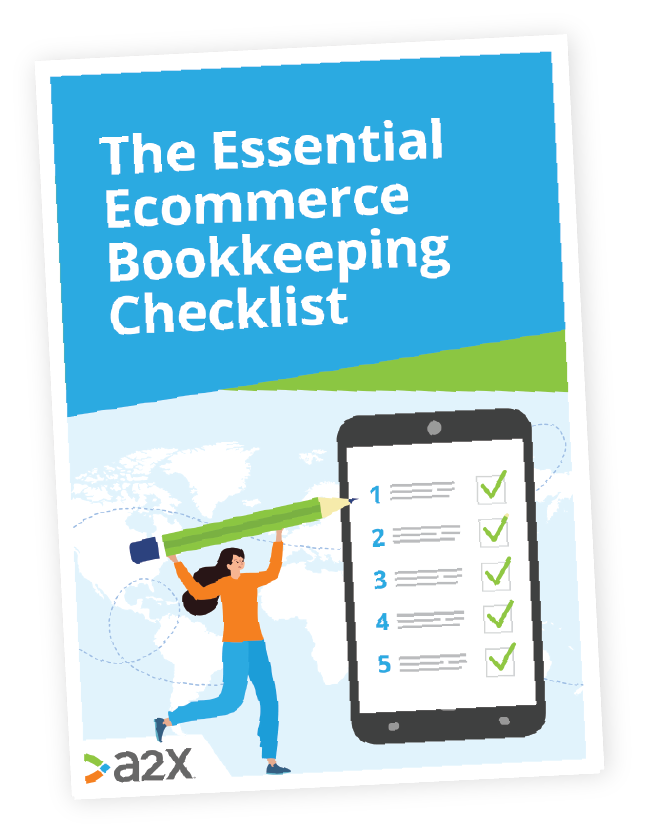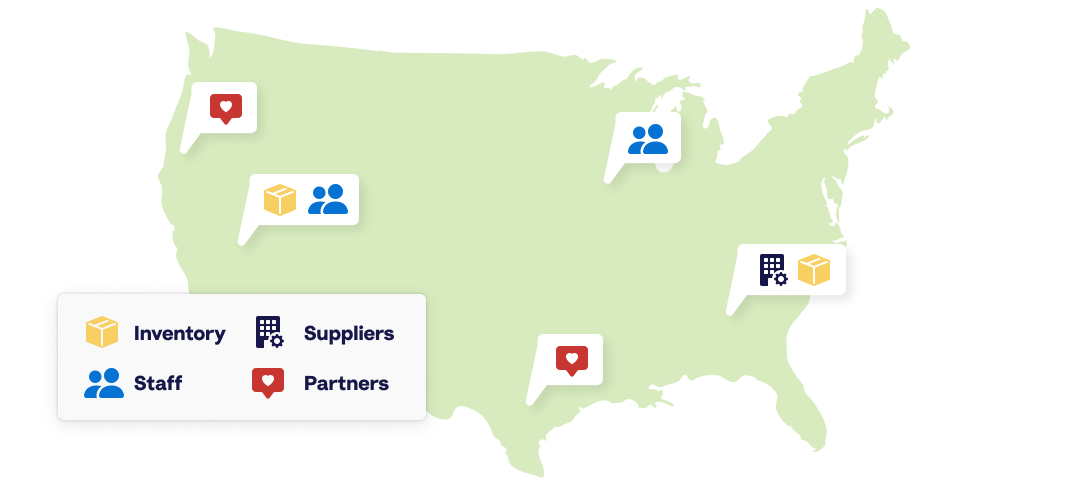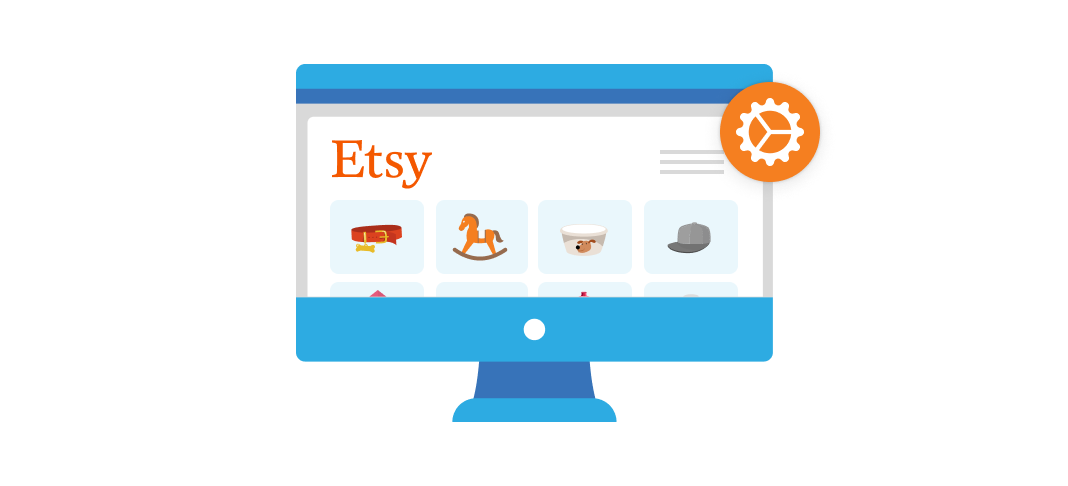
The Ultimate Etsy Sales Tax Guide
If you’re an Etsy seller concerned about whether you should be collecting sales tax yet, or how to remit it, then this guide is for you.
Sales tax can get confusing. Not only does every US state have its own criteria for when to pay but rates, rules, and filing frequencies differ too.
But you’re not in it alone.
There are plenty of ways you can successfully handle your sales tax that shouldn’t sink your business. After all, if you manage it properly, you’ll simply be passing it from your buyers to the appropriate state.
In this Etsy sales tax guide:
Table of Contents
Want to feel completely confident in your ecommerce bookkeeping?
Businesses that document their processes grow faster and make more profit. Download our free checklist to get all of the essential ecommerce bookkeeping processes you need every week, month, quarter, and year.
Download it here
Sales Tax: No Longer A Blurred Line for Ecommerce
Sales tax used to be a bit of a blurred line for ecommerce sellers.
Unless a business owner had a physical address in a state, they weren’t obligated to collect and remit sales tax.
This suited back in the day before ecommerce even existed, let alone was worth trillions. But the numbers went up, and so did the expectations of states.
It was worth too much money to ignore. In fact, by the time the new ruling took place, it was estimated that around 45 states were losing approx. $33 billion a year as a result.
And traditional brick-and-mortar stores were at a disadvantage, still subject to the sales tax admin online sellers were able to avoid.
In 2018, the landmark ruling of Quill v. Wayfair changed the landscape for ecommerce sellers for good. Sales tax had come for them.
Leveling the playing field for sales tax collection
The “Wayfair decision” shifted the goalposts for sales tax collection. A physical address was no longer a prerequisite for eligibility.
In a bid to protect both states and smaller sellers, nexus thresholds were put in place.
Sellers would need to meet a minimum revenue threshold in order for states to ask them to remit sales tax.
States were put in charge of handling this themselves, able to set their own rates and rules for sales tax collection.
As a result, every state has its own nexus threshold, rate, charge basis, and filing frequency. If you need to remit sales tax to more than one state, you’re in for a treat (not).
We’ll tackle what these are and how you can approach managing yours below.
So, does Etsy charge sales tax?
States require sellers to collect sales tax from their buyers when they meet the sales tax nexus threshold.
Etsy itself doesn’t charge sales tax, but in some cases, it may collect and remit it on your behalf.
This is due to the marketplace facilitator laws that emerged in 2017. They made platforms like Etsy responsible for ensuring that sellers were meeting their sales tax obligations.
Not every state exercises these marketplace facilitator laws, so we’ll take that into account as we explore how sales tax works for Etsy below.
How Sales Tax Works

The first thing you need to do in your journey to managing sales tax is to figure out your nexus states.
These are the states where you do business, and meet their criteria for nexus. This might be exceeding their revenue threshold, but it might also be:
- A state where you store inventory. For example, if you use Amazon FBA for your Etsy fulfilment, then every warehouse location that holds your inventory would qualify you for nexus there.
- A state where you have staff. If people work for you remotely, then you are considered to have nexus with their location state.
- State/s where your suppliers are located. If you operated a dropshipping business (which for Etsy is highly unlikely) then the location of your supplier/s would come into play too.
- The states of any affiliate partners. If you have affiliate partners, you may need to take their state’s nexus rules into consideration.
Make a list of all the locations in the US associated with your business on some level. This will give you a starting point for checking criteria and eligibility.
Nexus revenue thresholds by US state
This table will help you figure out whether you qualify for nexus in these states, and what that means for your business.
You have official links to the state websites to verify the latest information, as well as the average sales tax rate for the state.
That’s because, as you’ll see in another column below, states may have more than one tax jurisdiction and corresponding tax rate. As a result, an average state rate is commonly used for filing purposes to make things a little simpler.
There may, of course, be a little left to pay in these instances.
Where you have nexus, you need to register for a permit to collect and remit sales tax. You also won’t necessarily pay the rate of the state you have nexus with itself. And that’s what the origin/destination basis refers to below.
We’ll explore that next.
| State | Tax Basis for Home Sellers | Tax Basis for Remote Sellers | Nexus Threshold in $/per Annum* | Link to Official Site | Average Combined Tax | No. of Jurisdictions | Shipping & Handling Tax | Register for Tax Permit |
|---|---|---|---|---|---|---|---|---|
| Alabama (AL) | Destination | Destination | $250,000+ | AL | 8.36% | 805 | Here | |
| Alaska (AK) | Destination | Destination | $100,000+ | AK | 1.54% | 109 | ✅ | Here |
| Arizona (AZ) | Origin | Origin | $100,000+ | AZ | Calculate | 131 | Here | |
| Arkansas (AR) | Destination | Destination | $100,000+ | AR | 8.57% | 400 | ✅ | Here |
| California (CA) | Destination | Origin | $500,000+ | CA | 8.26% | 401 | Here | |
| Colorado (CO) | Destination | Destination | $100,000+ | CO | 6.47% | 305 | ✅ | Here |
| Connecticut (CT) | Destination | Destination | $100,000+ | CT | 6.35% | 2 | ✅ | Here |
| Delaware (DE) | Destination | Destination | (Other) | DE | 0.00% | 0 | Here | |
| District of Columbia (DC) | Destination | Destination | $100,000+ | DC | 6.00% | 1 | ✅ | Here |
| Florida (FL) | Destination | Destination | $100,000+ | FL | 6.82% | 67 | ✅ | Here |
| Georgia (GA) | Destination | Destination | $100,000+ | GA | 7.33% | 162 | ✅ | Here |
| Hawaii (HI) | Destination | Destination | $100,000+ | HI | 4.24% | 4 | ✅ | Here |
| Idaho (ID) | Destination | Destination | $100,000+ | ID | 6.04% | 12 | Here | |
| Illinois (IL) | Origin | Destination | $100,000+ | IL | Calculate | 635 | ✅ | Here |
| Indiana (IN) | Destination | Destination | $100,000+ | IN | 7.00% | 1 | ✅ | Here |
| Iowa (IA) | Destination | Destination | $100,000+ | IA | 6.89% | 1028 | Here | |
| Kansas (KS) | Destination | Destination | $100,000+ | KS | 8.05% | 594 | ✅ | Here |
| Kentucky (KY) | Destination | Destination | $100,000+ | KY | 6.00% | 1 | ✅ | Here |
| Louisiana (LA) | Destination | Destination | $100,000+ | LA | 9.58% | 388 | Here | |
| Maine (ME) | Destination | Destination | $100,000+ | ME | 5.50% | 1 | Here | |
| Maryland (MD) | Destination | Destination | $100,000+ | MD | 6.00% | 1 | Here | |
| Massachusetts (MA) | Destination | Destination | $100,000+ | MA | 6.25% | 1 | Here | |
| Michigan (MI) | Destination | Destination | $100,000+ | MI | 6.00% | 1 | ✅ | Here |
| Minnesota (MN) | Destination | Destination | $100,000+ | MN | 7.18% | 98 | ✅ | Here |
| Mississippi (MS) | Origin | Destination | $250,000+ | MS | Calculate | 3 | ✅ | Here |
| Missouri (MO) | Origin | Destination | $100,000+ | MO | Calculate | 1491 | ✅ | Here |
| Montana (MT) | Destination | Destination | (None) | MT | 0.00% | 10 | Here | |
| Nebraska (NE) | Destination | Destination | $100,000+ | NE | 5.86% | 252 | ✅ | Here |
| Nevada (NV) | Destination | Destination | $100,000+ | NV | 7.78% | 19 | Here | |
| New Hampshire (NH) | Destination | Destination | $50,000+ | NH | 0.00% | 0 | Here | |
| New Jersey (NJ) | Destination | Destination | $100,000+ | NJ | 6.63% | 2 | ✅ | Here |
| New Mexico (NM) | Origin | Origin | $100,000+ | NM | Calculate | 145 | ✅ | Here |
| New York (NY) | Destination | Destination | $500,000+ | NY | 8.19% | 78 | ✅ | Here |
| North Carolina (NC) | Destination | Destination | $100,000+ | NC | 6.90% | 106 | ✅ | Here |
| North Dakota (ND) | Destination | Destination | $100,000+ | ND | 5.51% | 154 | ✅ | Here |
| Ohio (OH) | Origin | Destination | $100,000+ | OH | Calculate | 96 | ✅ | Here |
| Oklahoma (OK) | Destination | Destination | $100,000+ | OK | 7.86% | 594 | Here | |
| Oregon (OR) | Destination | Destination | (All sellers) | OR | 0.00% | 0 | Here | |
| Pennsylvania (PA) | Origin | Destination | $100,000+ | PA | Calculate | 3 | ✅ | Here |
| Rhode Island (RI) | Destination | Destination | $100,000+ | RI | 7.00% | 1 | ✅ | Here |
| South Carolina (SC) | Destination | Destination | $100,000+ | SC | 7.36% | 46 | ✅ | Here |
| South Dakota (SD) | Destination | Destination | $100,000+ | SD | 5.60% | 258 | ✅ | Here |
| Tennessee (TN) | Origin | Destination | $100,000+ | TN | Calculate | 129 | ✅ | Here |
| Texas (TX) | Origin | Destination | $500,000+ | TX | Calculate | 1659 | ✅ | Here |
| Utah (UT) | Origin | Destination | $100,000+ | UT | Calculate | 321 | Here | |
| Vermont (VT) | Destination | Destination | $100,000+ | VT | 6.04% | 16 | ✅ | Here |
| Virginia (VA) | Origin | Destination | $100,000+ | VA | Calculate | 175 | Here | |
| Washington (WA) | Destination | Destination | $100,000+ | WA | 8.76% | 385 | ✅ | Here |
| West Virginia (WV) | Destination | Destination | $100,000+ | WV | 6.10% | 62 | ✅ | Here |
| Wisconsin (WI) | Destination | Destination | $100,000+ | WI | 5.46% | 76 | ✅ | Here |
| Wyoming (WY) | Destination | Destination | $100,000+ | WY | 5.29% | 24 | Here |
Sources used: TaxJar, Shopify, Avalara.
NB: There are states that don’t collect sales tax at all. These are referred to as N.O.M.A.D. states, due to their initials (New Hampshire, Oregon, Montana, Alaska, and Delaware).
Origin- and destination-basis
Right, here’s where things get a bit more juicy—and not in a good way.
If you have nexus with a state, you don’t necessarily pay that state its own tax rate. That would be too easy, right?
States operate on either an origin- or a destination-basis. That means that they either require you to collect and remit the tax rate of your location (the origin location of the product), or that of your customers (the destination location of the product).
Origin-based states are fairly simple—it’s wherever you’re based.
Destination-based states are more complicated. You might have lots of buyers in lots of different locations, so there’s a touch more admin involved.
Fear not, however. There are tax apps that can help you figure out what you need to pay where, as well as, of course, your accountant.
Don’t have one yet? Find one here.
How To Manage Your Etsy Sales Tax

By this stage, you should have an idea of your nexus states and the rate that they require you to pay.
Assuming now that Etsy isn’t doing the tax collection for you (if it is collecting sales tax for you, then you don’t need to do anything else), let’s take a look at setting this up manually.
Configuring your Etsy sales tax settings
You will need to add tax rates whilst your shop is open, and then apply them to your listings.
- Head to Shop Manager > Finances > Payment settings.
- Select the Sales tax tab.
- For US sellers, you’ll need to enter a state and ZIP code range. For sellers in Canada, you’ll need to select a province.
- Enter your tax rate in a decimal format.
- Repeat steps 3-4 for any additional locations and tax rates you want to collect.
- Click Save.
Once you have done this, your listings will have the appropriate tax rates applied by default. Just make sure that old listings have synced up correctly.
You do have the option not to charge tax on specific items. You can uncheck the box next to the item’s price during the listing process.
Filing sales tax for Etsy
You will need to collect your Etsy sales tax and keep it safe. That money belongs to the government.
Etsy settlement statements may not make it clear exactly how much sales tax you collected by bank deposit, so you’ll either need to dedicate some time to figuring this out each month, or integrate an app to do it for you accurately every time.
A2X for Etsy and QuickBooks Online or Xero calculates every income and expense line that goes into your bank deposits.
That includes sales tax, but it also includes your fees, costs, returns, and all the other granular information that you need to run your business profitably.
The value of A2X goes beyond sales tax collection, too.
It splits your settlements that span months and organizes books via the accrual method of accounting, so that not only can you ensure your sales tax is remitted correctly, but you can forecast your business performance month to month for the most efficient operations.
Tax apps to do it for you
For an added layer of reassurance, and assistance with the filing process itself, tax apps can be hugely beneficial for Etsy sellers.
They can be integrated with your accounting software, and help you set aside the correct amounts of tax for filing.
They give you the most up-to-date rates and filing frequencies, and often have services that will do it all for you.
TaxJar, Taxify, and Avalara are some of the most common top choices.
Your specialist ecommerce accountant
Sales tax for ecommerce is just one reason why having a specialist accountant on your side is important for businesses that want to grow sustainably.
We talk about this in more detail over in the Ecommerce Accounting Hub, in our Finding Your Specialist Ecommerce Accountant Guide, so if you’re unsure whether you need one yet or how to find them, check this out.
Ready to find a specialist ecommerce accountant? Go to the A2X directory now.
Etsy Sales Tax FAQs
Get quick answers to your burning Etsy sales tax questions right here.
Does Etsy charge sales tax now?
No, Etsy doesn’t charge you sales tax. Some US states require Etsy to collect and remit sales tax on your behalf, if you have nexus with a particular state. If you have nexus and Etsy isn’t required to manage this for you, then you’ll need to do it yourself.
Why is Etsy charging sales tax?
Etsy is required by law in some states to collect sales tax. A number of US states have enacted marketplace facilitator laws to help police sales tax collection, and in these states, Etsy automatically charges buyers sales tax.
Do you need a tax ID to sell on Etsy?
Not all sellers need to collect and remit sales tax on Etsy. If you have nexus with a state, and by extension need to collect and remit sales tax there, then you must register for a permit first. Once you have this tax ID, you can collect and remit sales tax through your Etsy store.
Are handmade items taxable?
Yes, absolutely. Handmade items are as taxable as other goods.
How do I remove sales tax from Etsy?
You can turn off sales tax collection on new listings on Etsy by unchecking the box next to the item price.
How does sales tax on Etsy compare to other channels?
The experience of Etsy sellers when it comes to sales tax will be similar to those of other marketplace facilitators like Amazon, eBay, and Walmart. But Shopify is not a marketplace facilitator, so it will not collect and remit taxes for any of its sellers. Shopify sellers are wholly responsible for collecting their own sales tax.
Otherwise, since the tax rates and rules are set by the government, ecommerce sellers across the board will have similar experiences and obligations.
Also on the blog
Want to feel completely confident in your ecommerce bookkeeping?
Businesses that document their processes grow faster and make more profit. Download our free checklist to get all of the essential ecommerce bookkeeping processes you need every week, month, quarter, and year.
Download it here

